These delicious dawali, also called waraq al dawali, are vegetarian stuffed grape leaves you can make a large batch of and enjoy all week!
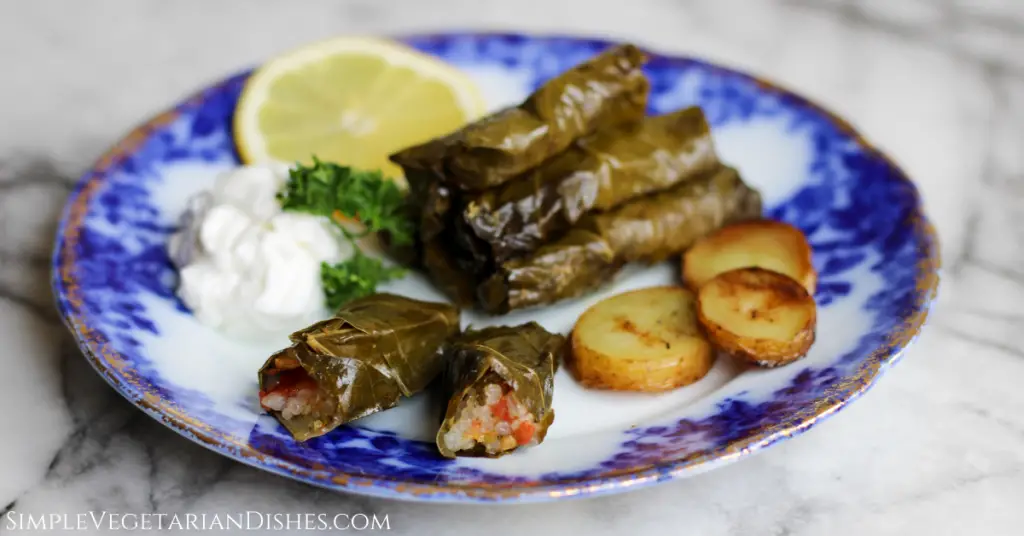
You’ll feel like you’re in a Mediterranean taverna once you taste these! I used a simple yet flavorful filling, but feel free to follow in the footsteps of those who add pine nuts, figs, dried apricots, cherries, plums, quince, celery, lentils, or anything else you’d like.
This recipe is a bit time consuming. That being said, you can customize it to your own tastes, and it makes a huge batch you can eat for quite a while. If there is someone in your household you can enlist to help you roll these up, all the better. The estimated time on the recipe card assumes you do all the work yourself, but if you enlist a friend you can get them rolled much faster.
These fresh stuffed vine leaves do taste, in my opinion, quite a bit better than the ones you can buy in a can. They are also quite a bit less oily.
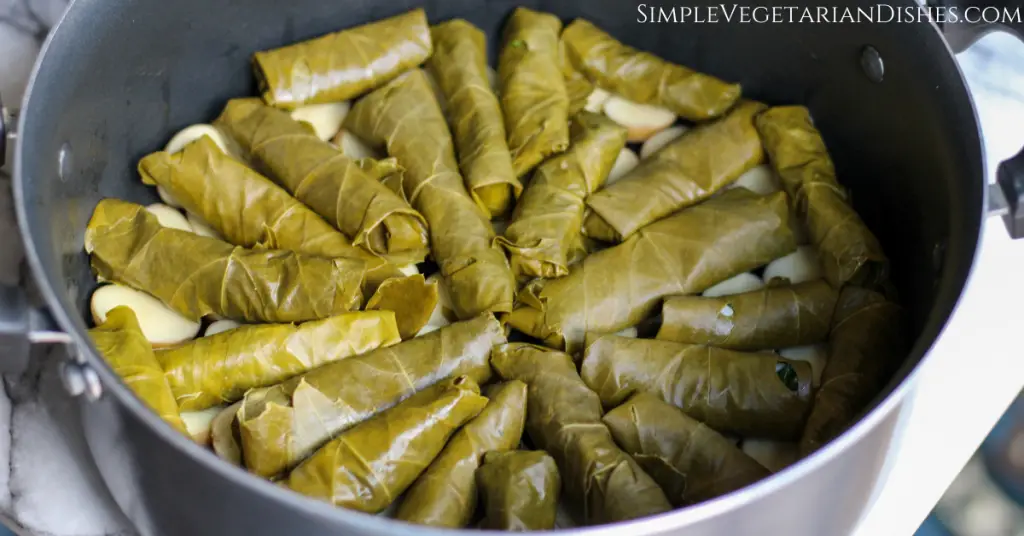
What is Dawali, or Warak Dawali?
This dish is a traditional food all around the Mediterranean. People generally eat it as a mezze, like my taboule. A mezze is an assortment of small dishes. People eat them either as appetizers, like tapas, or if you have enough of them they become a meal on their own. (My hommus recipe is another mezze you can make.)
Various regions make similar stuffed vine leaves by different names. This recipe is remarkably similar to Greek dolmades or dolmas, Egyptian warak enab, or Arabic war’a dawali.
Another variation is sarma, a type of dolma eaten throughout what used to be the Ottoman Empire.
Interestingly, in Turkish, yalanci dolma means fake dolma or liar’s dolma, and is what people sometimes call dolmas without meat.
In 2017, UNESCO (the United Nations Educational, Scientific and Cultural Organization, a specialized agency of the United Nations) added dolma making and sharing in Azerbaijan (a country in the Caucasus region of Eurasia) to its UNESCO Intangible Cultural Heritage Lists. You can read more about how the cooking and sharing of dolmas fits in to their hospitality and cultural identity here.
How to roll stuffed grape leaves
- To begin, lay your leaf on a flat surface, veiny side up.
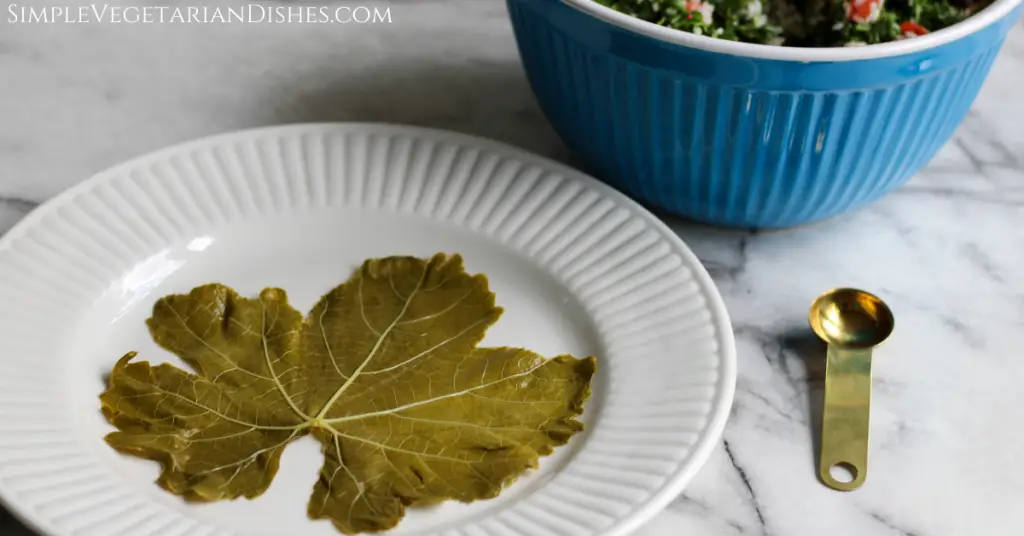
2. Then, add your filling horizontally near where the stem would be. For small leaves, about a teaspoon of filling will do, but for larger ones like this I did very heaping teaspoons (like almost two).
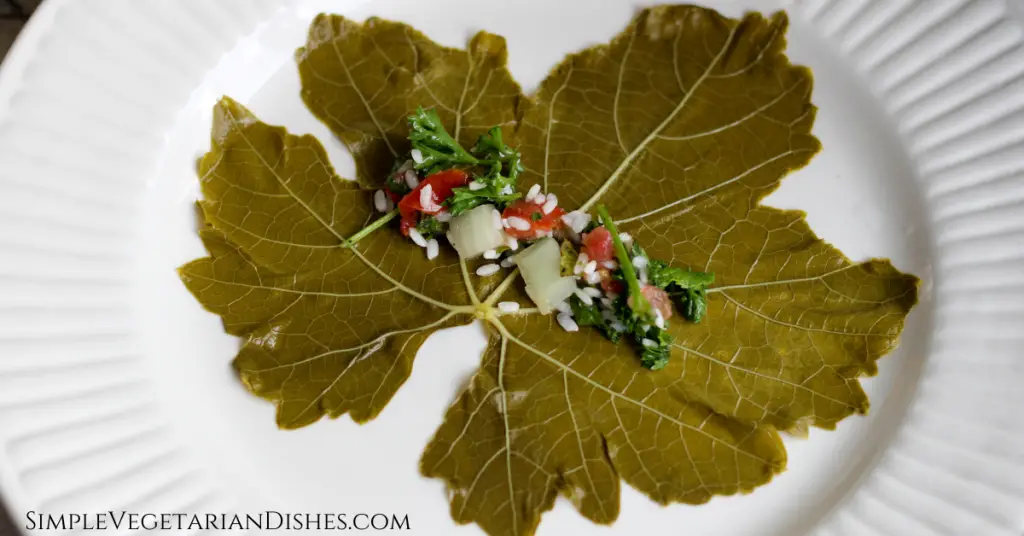
3. Next, fold up the bottom flaps of the grape leaf to cover the filling.
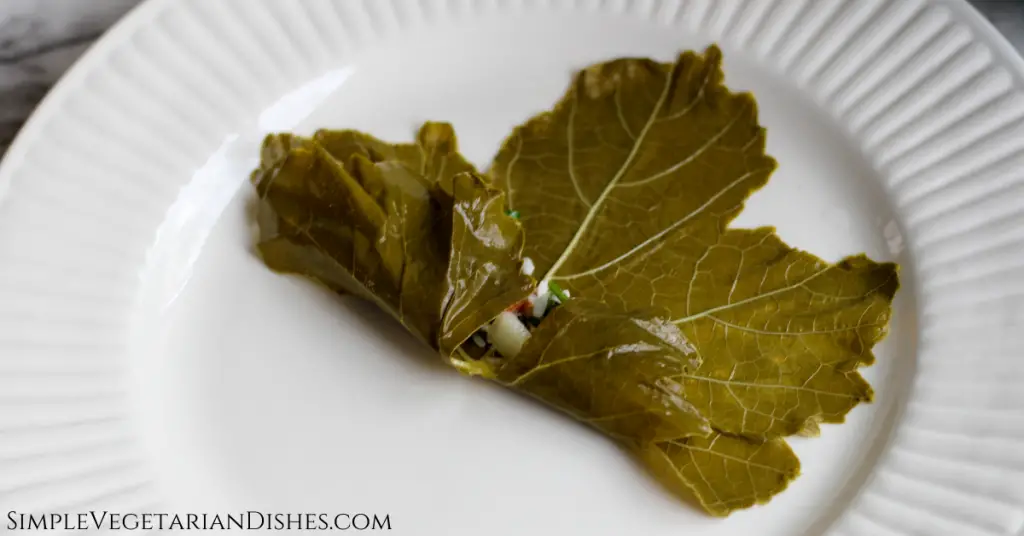
4. After that, fold the side flaps of the grape leaf in like an envelope.
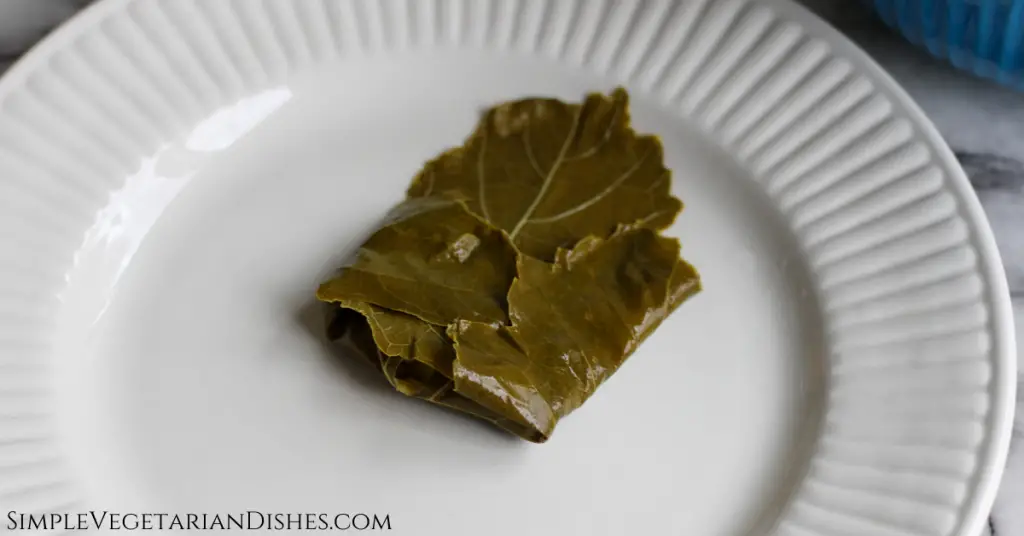
5. Finally, roll up your dawali. You don’t need to roll it very tightly since the rice will expand as it cooks. Lay it seam side down in your pot over a protective bottom layer of sliced potatoes or the grape leaves with holes, etc.
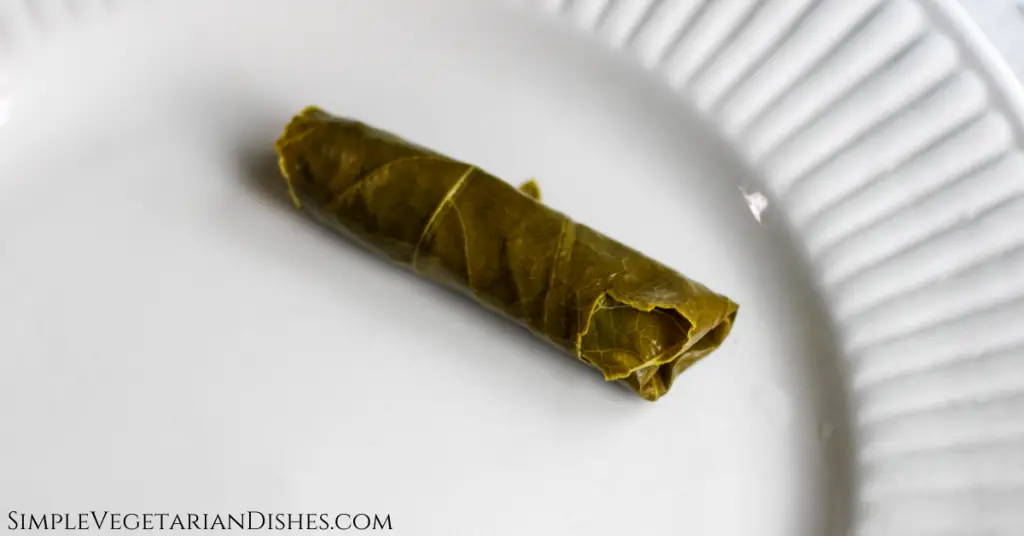
Dawali Ingredients
Before you begin, you will need:
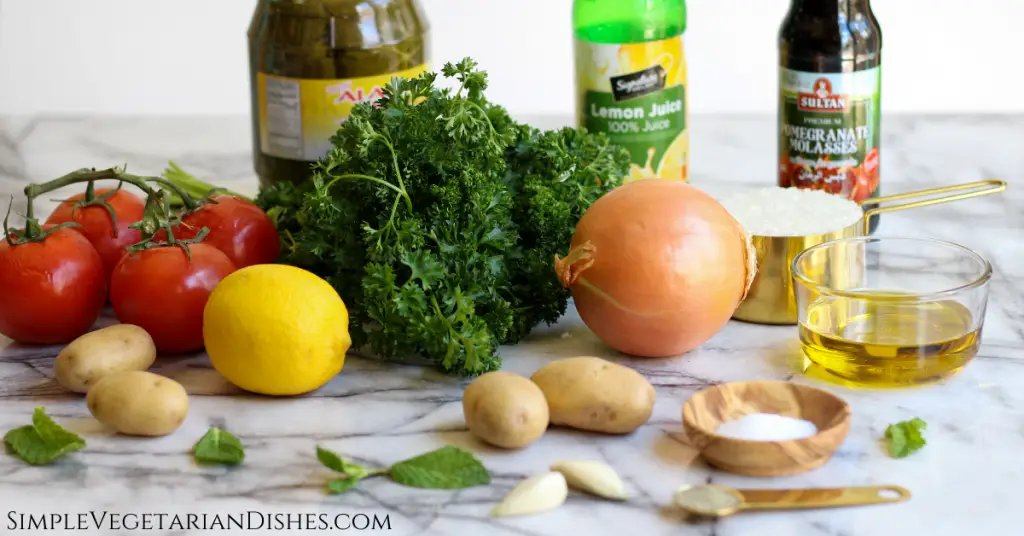
Edible Ingredients
- 1 1/2 cups rice, medium or short grained
- 1 bunch of parsley
- 4 tomatoes, medium (if you have large tomatoes, you can chop 3 and stuff the 4th with leftover filling and set it on top of the grape leaves to cook)
- 1/4 cup chopped fresh mint
- 2 cloves fresh garlic
- 1/2 a large yellow onion
- 1 tsp salt
- 1/2 tsp pepper
- 1 cup lemon juice (if you don’t like lemon as much as me, you can substitute vegetable broth for some of this)
- 1/3 cup olive oil
- 1 cup water
- 1 16 ounce jar of grape leaves
- 2-3 russet potatoes (optional, but if you’re going to cook, you may as well have lots of leftovers)
Tools and Equipment
- The widest cooking pot you own – the bottom two layers of stuffed grape leaves will get really soft, but if too much liquid cooks off, the top layer won’t be as tender
- Knife and cutting board
- Measuring cups and spoons
- Garlic press (or allow more time for mincing)
- Large plate or cutting board for rolling
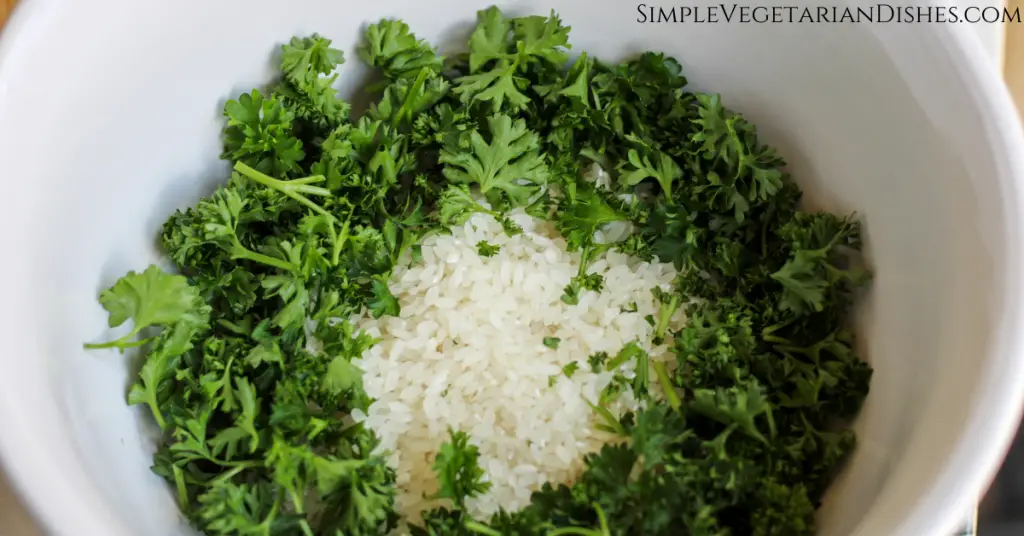
How to make Dawali (Stuffed Grape Leaves)
First, make the stuffing
- To begin, wash your rice and put it in a large mixing bowl once it’s drained.
- Next, wash and chop your parsley. Add it to the rice.
- Then, wash and chop the tomatoes and add them to the bowl.
- Now, peel and chop as much of the onion as you are using and add it to the bowl as well.
- After that, peel and trim the ends from the garlic. Mince it or use a garlic press and add that to the bowl, too.
- Stir in the salt and pepper.
- Add 1/4 cup of the lemon juice and 2 Tbsp of the olive oil and stir until well combined. Let your filling sit while you prepare the pan so the rice can absorb some liquid.
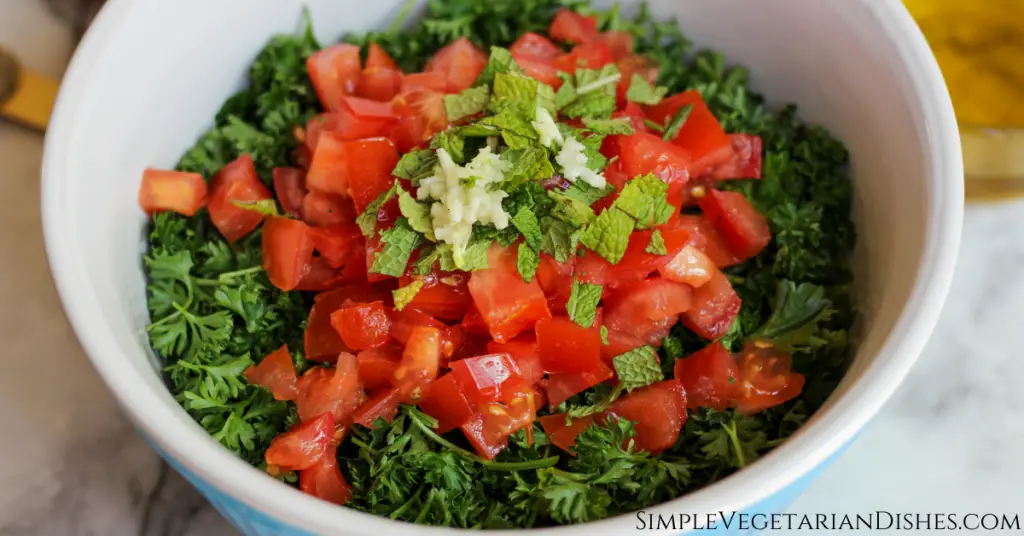
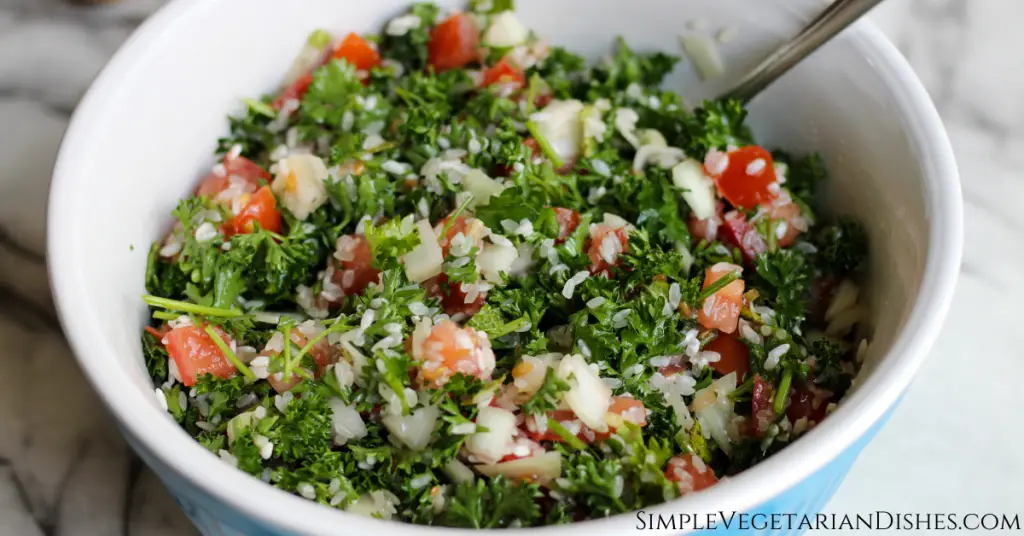
Prepare the bottom layer of your pot
- Next up, scrub your potatoes and slice them into thin rounds.
- Then, brush some additional olive oil around the bottom of a large pot (like a Dutch oven) and make a layer of potato slices covering the bottom. (If you are not using potatoes, put down a layer of grape leaves, like the torn ones or the ones with holes. Otherwise your dawali will stick to the bottom and burn.)
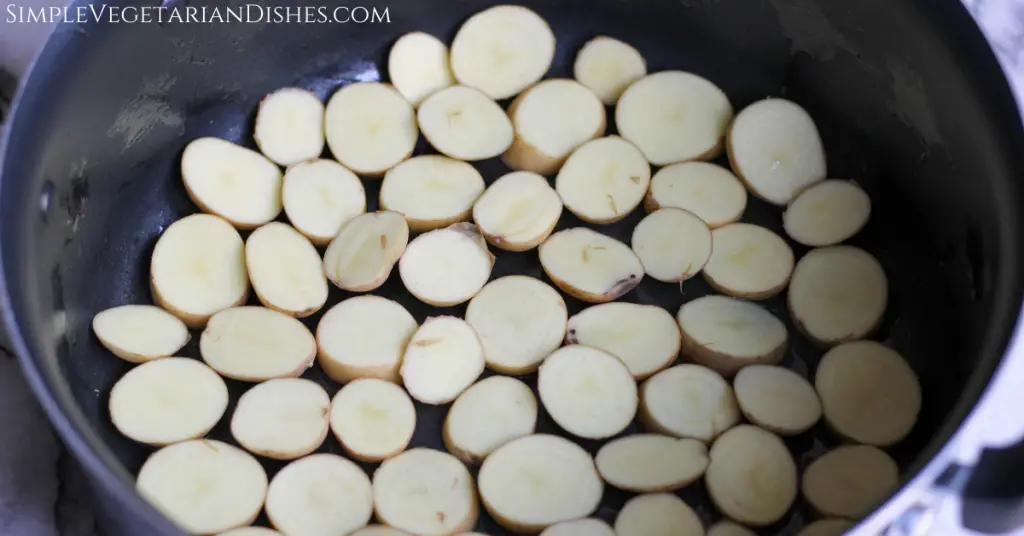
Now, prepare your rolling station (see photos above)
- After that, open the jar of grape leaves. If yours has a white plastic cage holding the leaves down in the brine, you can just push all four sides to the middle and then you should be able to remove it.
- Pull out and rinse a handful of grape leaves and place them in a colander to drain. Place the colander on a plate for ease of clean up.
- Now, set up your grape leave rolling station. On a large, clear surface like a kitchen table or countertop, you will need your colander of grape leaves, a dinner plate or cutting board to roll on, your rice filling, and the pot with the potatoes.
Next, roll the dawali
- One at a time, unroll each grape leaf flat on your surface, veiny side up. Place a thin line (a heaping teaspoon for the larger leaves, or just a teaspoon for the smaller ones) of filling horizontally where the stem would have been, so the line of filling is perpendicular to the main, central vein of your leaf.
- Next, tuck the bottom two flaps of the leaf up around the filling.
- Then, fold the side flaps over like an envelope.
- After that, gently roll the stuffed grape leaf up like a little burrito. You don’t need to wrap them very tightly, as the rice will expand quite a bit as it cooks. Just tuck in the corners and get the shape mostly right.
- Place your completed stuffed grape leaf seam side down on top of the layer of potato slices in the pot. Repeat until you have enough stuffed grape leaves to cover the bottom of the pot. You can fan them out to make it look nice, or just cram them in. They can be pressed pretty closely together, which will help them keep their shape as they cook.
- Depending on how much stuffing you have left/how big your pot is, you can repeat this and do a second and/or a third layer of stuffed grape leaves. If you want, add some of the torn or holey grape leaves in between layers, but this is not necessary. Try to squish them into just two layers, or if you need a third, plan to add more water.
Finally, cook the stuffed grape leaves
- If you have any liquid left in the mixing bowl from your stuffing, pour that evenly over the pot. Add the rest of the lemon juice, olive oil, and water. (If you have a third layer, you will need more water. Keep adding water until it comes just about to the top of your grape leaves.)
- Bring the pot to a boil over medium heat, then reduce the heat to a low boil (just above a simmer) and cook for about an hour, checking it every 15-20 minutes to make sure you still have enough water. (With a third layer you will likely need to replenish the water.) Try it and see if it’s done to your liking. You can serve these warm, room temperature or cold, with yogurt, tzatziki, or hummus if desired. Enjoy!
Pin it for later!
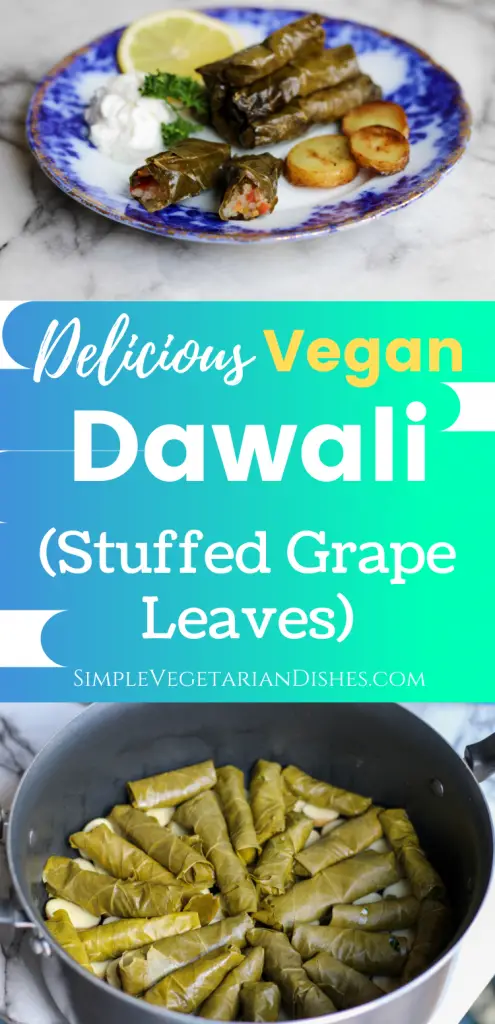
Variations on these vegetarian stuffed grape leaves
Feel free to change up the filling. I made mine fairly plain so I knew I’d love them, but people add things like dill, sumac, allspice, cloves, cinnamon, raisins, currants, chestnuts, diced apples, or sometimes meat.
Some variations, especially in Eastern Europe, use different wrappers, like chard, kale, or cabbage leaves instead of grape vine leaves. In Egypt, for example, people use cabbage leaves in the winter and grape leaves in the summer.
As I mentioned in the ingredients section, feel free to use vegetable broth or even vinegar in place of some (or all) of the lemon juice if you don’t want that much lemon flavor.
If you found this article helpful, please consider joining my email newsletter community for new recipes delivered straight to your inbox!
Related Mezze Posts
Try serving these dawali alongside my taboule recipe, hommus, and/or my Arabic salad for a Mediterranean feast!
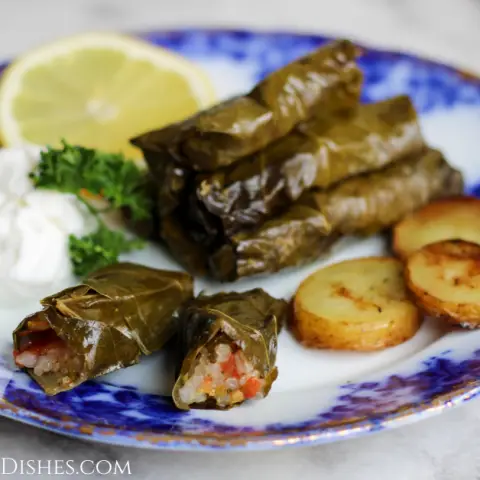
Dawali (Vegan Stuffed Grape Leaves You Will Love)
These delicious dawali, also called waraq al dawali, are vegetarian stuffed grape leaves you can make a large batch of and enjoy all week!
Ingredients
- 1 1/2 cups white rice, medium or short grained
- 1 bunch of fresh parsley
- 4 tomatoes, medium
- 1/4 cup fresh chopped mint leaves
- 2 cloves fresh garlic
- 1/2 a large yellow onion
- 1 cup lemon juice
- 1/3 cup olive oil
- 1 cup water
- 1 tsp salt
- 1/2 tsp pepper
- 1 16 ounce jar of grape leaves
- 2 russet potatoes
Instructions
Stuffing
- To begin, wash your rice and put it in a large mixing bowl once it's drained.
- Next, wash and chop your parsley. Add it to the rice.
- Then, wash and chop the tomatoes and add them to the bowl.
- Now, peel and chop as much of the onion as you are using and add it to the bowl as well.
- After that, peel and trim the ends from the garlic. Mince it or use a garlic press and add that to the bowl, too.
- Stir in the salt and pepper.
- Add 1/4 cup of the lemon juice and 2 Tbsp of the olive oil and stir until well combined. Let your filling sit while you prepare the pan so the rice can absorb some liquid.
Base layer of pot
- Next up, scrub your potatoes and slice them into thin rounds.
- Then, brush some additional olive oil around the bottom of a large pot (like a Dutch oven) and make a layer of potato slices covering the bottom. (If you are not using potatoes, put down a layer of grape leaves, like the torn ones or the ones with holes. Otherwise your dawali will stick to the bottom and burn.)
Grape leaves
- After that, open the jar of grape leaves. If yours has a white plastic cage holding the leaves down in the brine, you can just push all four sides to the middle and then you should be able to remove it.
- Pull out and rinse a handful of grape leaves and place them in a colander to drain. Place the colander on a plate for ease of clean up.
- Now, set up your grape leave rolling station. On a large, clear surface like a kitchen table or countertop, you will need your colander of grape leaves, a dinner plate or cutting board to roll on, your rice filling, and the pot with the potatoes.
Roll the dawali
- One at a time, unroll each grape leaf flat on your surface, veiny side up. Place a thin line (a heaping teaspoon for the larger leaves, or just a teaspoon for the smaller ones) of filling horizontally where the stem would have been, so the line of filling is perpendicular to the main, central vein of your leaf.
- Next, tuck the bottom two flaps of the leaf up around the filling.
- Then, fold the side flaps over like an envelope.
- After that, gently roll the stuffed grape leaf up like a little burrito. You don't need to wrap them very tightly, as the rice will expand quite a bit as it cooks. Just tuck in the corners and get the shape mostly right.
- Place your completed stuffed grape leaf seam side down on top of the layer of potato slices in the pot. Repeat until you have enough stuffed grape leaves to cover the bottom of the pot. You can fan them out to make it look nice, or just cram them in. They can be pressed pretty closely together, which will help them keep their shape as they cook.
- Depending on how much stuffing you have left/how big your pot is, you can repeat this and do a second and/or a third layer of stuffed grape leaves. If you want, add some of the torn or holey grape leaves in between layers, but this is not necessary. Try to squish them into just two layers for best results.
Cook
- If you have any liquid left in the mixing bowl from your stuffing, pour that evenly over the pot. Add the rest of the lemon juice, olive oil, and water. (If you have a third layer, you will need more water. Keep adding water until it comes just about to the top of your grape leaves.)
- Bring the pot to a boil over medium heat, then reduce the heat to a low boil (just above a simmer) and cook for about an hour, checking it every 15-20 minutes to make sure you still have enough water. (With a third layer you will likely need to replenish the water.) Try it and see if it's done to your liking. You can serve these warm, room temperature or cold, with yogurt, tzatziki, or hummus if desired. Enjoy!
Nutrition Information:
Yield: 20 Serving Size: 4Amount Per Serving: Calories: 88Total Fat: 4gSaturated Fat: 1gTrans Fat: 0gUnsaturated Fat: 3gCholesterol: 0mgSodium: 771mgCarbohydrates: 12gFiber: 3gSugar: 1gProtein: 2g

Susan
These look delicious! Where do you buy jarred grape leaves? I’ve never see them anywhere.
TaraSVD0
Thanks Susan! First I checked a normal grocery store and a health food store, to no avail. I did a quick Google search and actually found them at Wal-Mart!
Ada
I have tried it before but I never knew how to make them. Thank you so much for sharing! Looks delicious!!!!
TaraSVD0
Thanks Ada, enjoy!
Errika
This sounds different than what I’m used to cooking but SO GOOD! I love finding new interesting recipes to try. Thanks!
TaraSVD0
Thanks Errika, I hope you like these dawali!
Maya
Looks Great! Do you add water or broth when you first start cooking them? Under Cook #1, you say to wait until it starts boiling, but no additional liquid was added to the pot, right? Am I missing something? Thanks for the recipe.
TaraSVD0
Hi Maya! Good question! You can certainly put in half of the olive oil and half of the lemon juice right away so nothing burns. I had some liquid left over from the stuffing (mostly tomato juice), so that’s all I used at first. I think there was enough liquid in just that and the stuffed grape leaves to create condensation that I could hear boiling, but upon reflection, there is no need to wait before adding additional cooking liquid. I hope they turn out amazing!